Philodendron plants has witnessed an unprecedented surge in popularity, captivating the hearts of plant enthusiasts far and wide. This can be attributed to their awe-inspiring foliage, low-maintenance nature, and adaptability to diverse indoor environments. Selecting the ideal philodendron can be overwhelming. Luckily, we pulled together a list of the most popular Philodendron plants, organized by the trendiest plants collectors are seeking today, as well as the best Philodendrons with easier care requirements that are absolutely perfect for beginners.
Read on as we explore the stunning, waxy-leafed world of the Philodendron plant!
Introduction to Philodendron Plants
Philodendron plants: With their stunning foliage and easy care requirements, it’s no wonder these tropical beauties have become a staple in many homes and offices. Hailing from the Araceae family and native to the rainforests of Central and South America, philodendrons boast lush green leaves and unique growth patterns that are simply mesmerizing.
But what sets philodendron plants apart from the rest? Well, one of their most remarkable qualities is their ability to thrive in a variety of environments. These adaptable plants can handle different light conditions with ease, making them perfect for both bright, indirect light and low-light areas. Talk about versatility! This makes philodendrons an excellent choice for those who may not have access to an abundance of natural light.
Now, let’s talk about their low maintenance requirements. Philodendrons are known for their resilience and ability to tolerate occasional neglect. They can survive in a wide range of temperatures, but they do prefer warm and humid conditions. So, a little regular watering and the occasional misting session will keep these plants happy and healthy. Like many other houseplants, these green wonders help purify the air by removing toxins and releasing oxygen. This means they can improve indoor air quality and create a healthier living environment. And if that wasn’t enough, studies have shown that being around plants can actually reduce stress levels and enhance overall well-being. It’s like having a personal therapist right in your living room!
Now, let’s dive into the world of philodendron plants and explore some of the most popular varieties that have stolen the hearts of plant lovers worldwide. From classic varieties to newer hybrids, these plants are sure to bring a touch of natural beauty to any space. And the best part? They require minimal effort to maintain. So whether you’re a seasoned plant enthusiast or a beginner looking to start your indoor garden, philodendrons are an excellent choice to consider. Get ready to embark on a journey of greenery and wonder!
Understanding the Appeal of Philodendrons
Philodendrons, those captivating plants that have taken the gardening world by storm, have become a favorite among plant enthusiasts and homeowners alike. Their unique characteristics and stunning foliage make them an irresistible choice for both indoor and outdoor gardening. But what exactly is it about philodendrons that make them so appealing? Let’s dive into their captivating features and the benefits they offer, shall we?
First and foremost, let’s talk about their foliage. Oh, the foliage! It’s varied and striking, offering a wide range of leaf shapes, sizes, and colors. From heart-shaped leaves to deeply lobed ones, philodendrons give you a plethora of options to suit your aesthetic preferences. They are like a chameleon, effortlessly blending into any interior or garden design. These resilient plants can thrive in various conditions, tolerating a range of light levels from bright indirect light to partial shade. And when it comes to watering, they are quite forgiving. You can occasionally neglect them or overwater them, and they’ll still be there, standing tall and proud.
Now, let’s talk about their air purifying properties. Yes, you heard it right! Philodendrons are not just pretty faces; they are also superheroes when it comes to improving indoor air quality. These plants have the power to effectively remove toxins such as formaldehyde, benzene, and xylene from the air, creating a healthier and more refreshing indoor space. It’s like having your very own air purifier, but in the form of a beautiful plant. You can grow them in hanging baskets, on trellises, or let them climb up walls, allowing for creative and space-saving arrangements. And their adaptability to different light conditions makes them suitable for any area within your home. Whether it’s your living room, bedroom, bathroom, or even your office, philodendrons will thrive and bring life to any space.
Now, let’s talk about propagation and growth. Philodendrons are relatively easy to propagate, making them a favorite among plant enthusiasts who love expanding their collection. You can simply take stem cuttings and create new plants from existing ones. It’s like magic! And let’s not forget about their vigorous growth. These plants are known for producing new leaves regularly, adding to their visual appeal and making them a joy to watch as they flourish.
Last but not least, let’s talk about the tropical aesthetic that philodendrons bring to the table. Native to tropical regions, these plants bring a touch of paradise into any space. Their vibrant green leaves and ability to create a dense canopy make them reminiscent of lush rainforests. Just imagine the tranquility and natural beauty they can bring to your indoor or outdoor setting. It’s like having your own little tropical getaway right at home.
The appeal of philodendrons is undeniable. Their varied and striking foliage, low maintenance requirements, air-purifying properties, versatility in placement, ease of propagation, and ability to create a tropical ambiance make them a must-have for any plant lover. Whether you’re a seasoned enthusiast or a beginner gardener, philodendrons offer an excellent choice for adding beauty and greenery to your surroundings. So go ahead, embrace the allure of philodendrons and let them transform your space into a botanical paradise.
Exploring the Diversity of Philodendron Species
Philodendrons, oh what a fascinating and diverse group of plants they are! Belonging to the Araceae family, these tropical beauties have managed to capture the hearts of plant enthusiasts all around the globe. With a whopping 500 known species, it’s no wonder they are such a popular choice for both indoor and outdoor gardening.
Let’s dive into the world of philodendrons and explore some of the most beloved species, shall we? First up, we have the Philodendron hederaceum, also known as the Heartleaf Philodendron. This particular species boasts leaves that are not only heart-shaped but also glossy and deep green in color. Talk about a showstopper! What’s even more impressive is its ability to thrive in various light conditions, making it the perfect choice for beginners. You can often spot the Heartleaf Philodendron cascading from hanging baskets or elegantly climbing up trellises, adding a touch of sophistication to any space.
Now, let’s move on to the Philodendron bipinnatifidum, or as some like to call it, the Split-Leaf Philodendron or Monstera deliciosa. This species is easily recognizable thanks to its large, fenestrated leaves that have unique splits and holes. It’s a real head-turner, let me tell you! The Split-Leaf Philodendron is a statement plant that can grow to impressive sizes, making it a popular choice for interior design. Its foliage is truly one-of-a-kind, bringing a tropical vibe to any room and creating an atmosphere that is both lush and vibrant.
Ah, the Philodendron scandens, also known as the Sweetheart Philodendron. This trailing plant is a favorite among plant enthusiasts, and it’s not hard to see why. Its heart-shaped leaves are a vibrant shade of green, adding a pop of color to any space. The Sweetheart Philodendron is incredibly versatile, making it an excellent choice for hanging baskets or as a climbing plant. It can adapt to different environments with ease, and its low-maintenance nature is a dream come true for those looking to add a touch of greenery to their homes.
Last but certainly not least, we have the Philodendron selloum, also known as the Tree Philodendron or Philodendron bipinnatifidum. This species is a true showstopper with its large, deeply lobed leaves that resemble the foliage of a tree. If you’re looking to create a tropical paradise in your outdoor space, the Tree Philodendron is the way to go. It can tolerate a wide range of light conditions and is relatively easy to care for, making it a favorite among gardeners.
These examples only scratch the surface of the vast array of philodendron species available to plant enthusiasts. Each species has its own unique beauty and characteristics, allowing individuals to find the perfect philodendron that suits their preferences and gardening needs. Whether you’re a beginner or an experienced gardener, rest assured that there is undoubtedly a philodendron species out there that will captivate you with its stunning foliage and easy-care nature
Top 5 Popular Philodendron Varieties
Philodendron Birkin
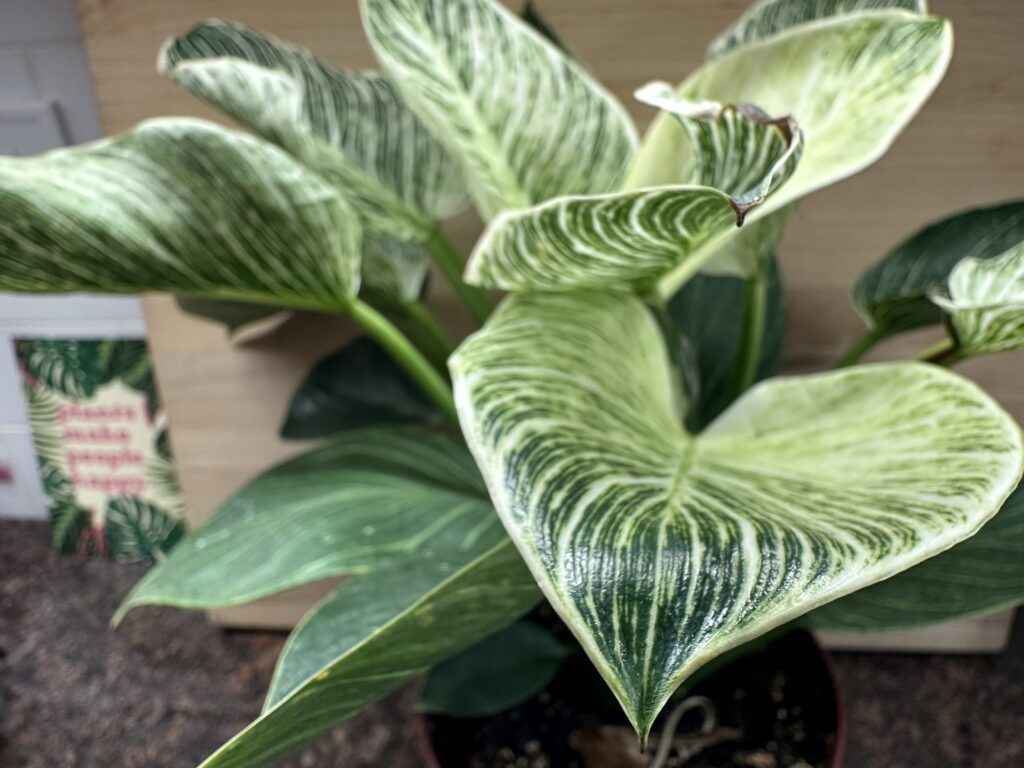
The Philodendron Birkin, a plant that has gained immense popularity in recent years, is known for its stunning variegated foliage. Its leaves, with their dark green color and striking white pinstripes, create a unique and eye-catching appearance. This compact plant is relatively easy to care for, making it a favorite among both experienced and novice plant enthusiasts.
To ensure this plant thrives in your care, there are some basic care guidelines to follow. First is lighting. It requires bright, indirect light to maintain its beautiful variegation. Avoid placing this philodendron in direct sunlight as it may scorch the leaves. A well-lit room or a spot near a north-facing window is usually ideal.
In terms of water needs, keep the soil consistently moist but not waterlogged. Allow the top inch of the soil to dry out between waterings, but don’t let it become bone dry. Overwatering can lead to root rot, so it’s essential to strike the right balance. Additionally, misting the leaves occasionally can help create a humid environment, which mimics its natural habitat and promotes healthy growth, although this plant (like all philodendrons) may need additional humidity from a humidifier if your home gets particularly dry during the winter or summer extremes.
Finally, Philodendron Birkin benefits from regular fertilization during the growing season (spring and summer). You can use a balanced liquid fertilizer or a specific houseplant fertilizer at half the recommended strength. Avoid fertilizing during the winter months when the plant is in a dormant phase. As with any houseplant, keep an eye out for any signs of pests or diseases, and promptly address any issues to keep your Philodendron Birkin looking its best. By providing the right amount of light, water, and nutrients, you’ll enjoy a stunning and thriving plant that adds a touch of elegance to your indoor space.
Philodendron Pink Princess
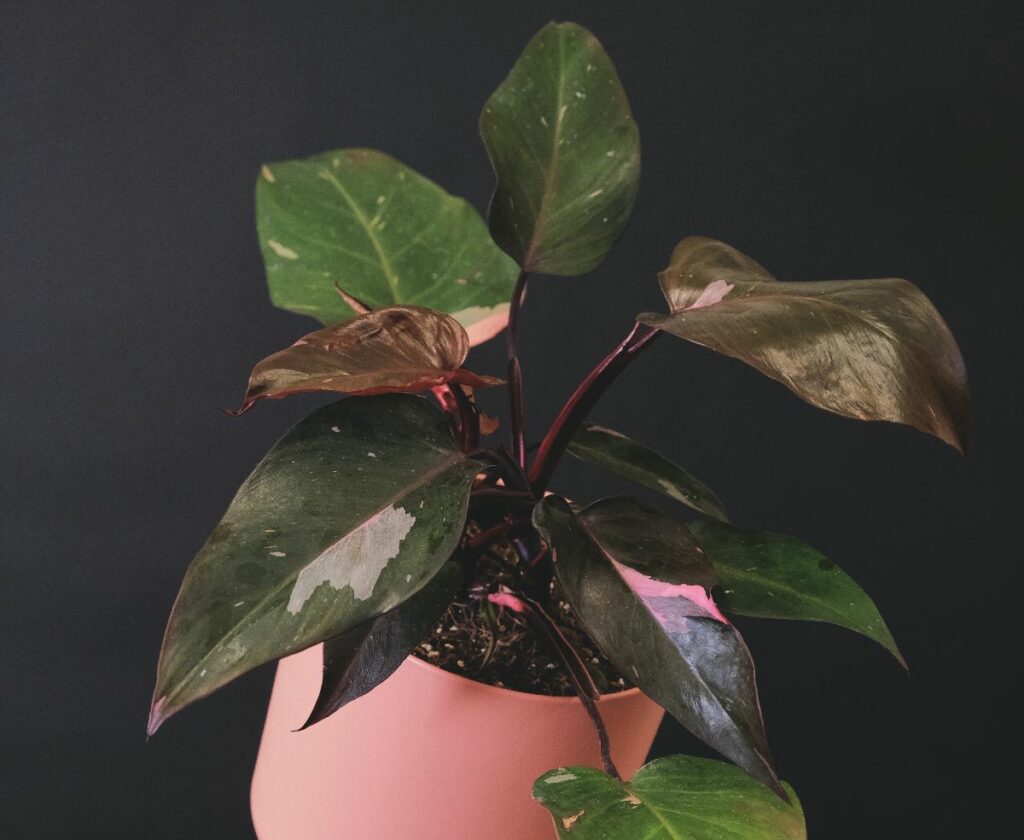
Moving on to the Philodendron Pink Princess, this variety is highly sought-after due to its vibrant pink variegation. The leaves of this plant display a mix of dark green and pink, creating a stunning contrast. To thrive, the Philodendron Pink Princess requires bright indirect light and regular watering. However, due to its popularity, finding this plant can be quite challenging and expensive.
In orer to keep its stunning pink variegation on its dark green leaves, healthy growth and vibrant colors, proper care is essential. Like the Birkin mentioned above, this plant thrives in bright, indirect light. It should be placed in a location where it receives filtered sunlight or indirect light for several hours a day. As a tropical that evolved in the rainforest canopy, direct sunlight can quickly scorch the leaves, so it’s crucial to protect it from harsh rays.
In terms of watering needs, the Philodendron Pink Princess prefers a well-draining potting mix that retains some moisture but doesn’t become soggy. Allow the top inch or two of the soil to dry out before watering, and then water thoroughly until the excess water drains from the bottom of the pot. Avoid overwatering, as it can lead to root rot. During the growing season, typically spring and summer, the plant may require more frequent watering, but reduce watering during the winter when it goes into a dormant phase.
Finally, added nutrients can benefit your Pink Princess with occasional feeding during its active growing months. You can use a balanced liquid fertilizer or a fertilizer specifically formulated for houseplants. Follow the manufacturer’s instructions and avoid over-fertilizing, as it can lead to nutrient imbalances. Regularly dust or wipe the leaves to keep them clean and free from dust, which can obstruct sunlight absorption. With proper care and attention to its lighting, watering, and feeding needs, your Philodendron Pink Princess will flourish and become a true gem in your indoor plant collection.
Philodendron Brasil
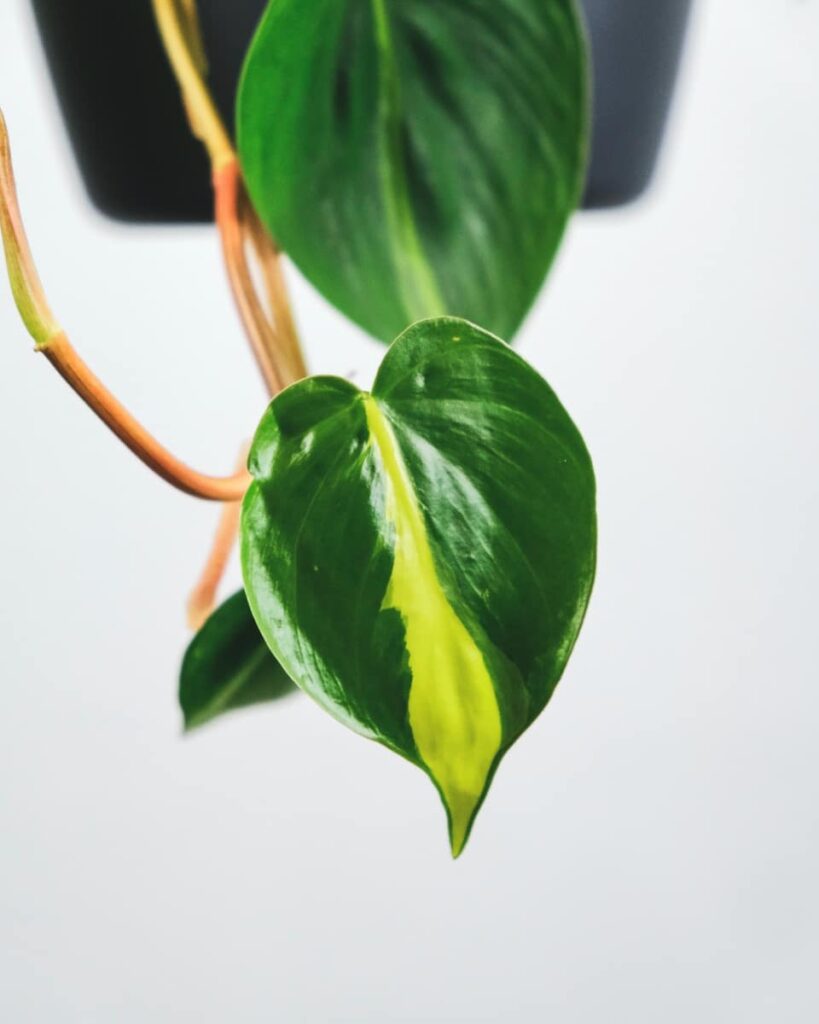
Now let’s talk about the Philodendron Brasil, a popular choice for those seeking a low-maintenance and versatile plant. Its heart-shaped leaves feature a vibrant combination of green and yellow, adding a pop of color to any space. What makes this variety even more appealing is its ability to tolerate a wide range of light conditions, making it suitable for both bright and low-light environments.
With minimal work, you can keep a Philodendron Brasil happy and thriving, producing feed upon feet of newly variegated vining leaves. Common to all Philodendrons, this plant thrives in moderate to bright, indirect light. While it can tolerate lower light conditions, it will grow more vigorously and showcase more intense variegation in brighter spots. Avoid exposing it to direct sunlight for extended periods as it can lead to sunburned leaves.
When it comes to watering, the Philodendron Brasil prefers a moderately moist soil. Water the plant thoroughly when the top inch of the soil feels dry to the touch. Ensure that the pot has drainage holes to prevent waterlogged roots, which can cause root rot. During the winter months or when the plant’s growth slows down, you may need to adjust the watering frequency and allow the soil to dry out a bit more between waterings.
As a tropical plant, the Philodendron Brasil enjoys a humid environment. You can increase humidity by misting the leaves regularly or placing the plant on a pebble tray filled with water. However, it can adapt to average household humidity levels as well. Fertilize the Philodendron Brasil every 4-6 weeks during the growing season (spring and summer) using a balanced liquid fertilizer. Pruning is not often necessary, but you can trim away any yellowing or damaged leaves to encourage new growth. With these basic care tips, your Philodendron Brasil will thrive and bring joy to your indoor space with its beautiful foliage.
Philodendron Micans
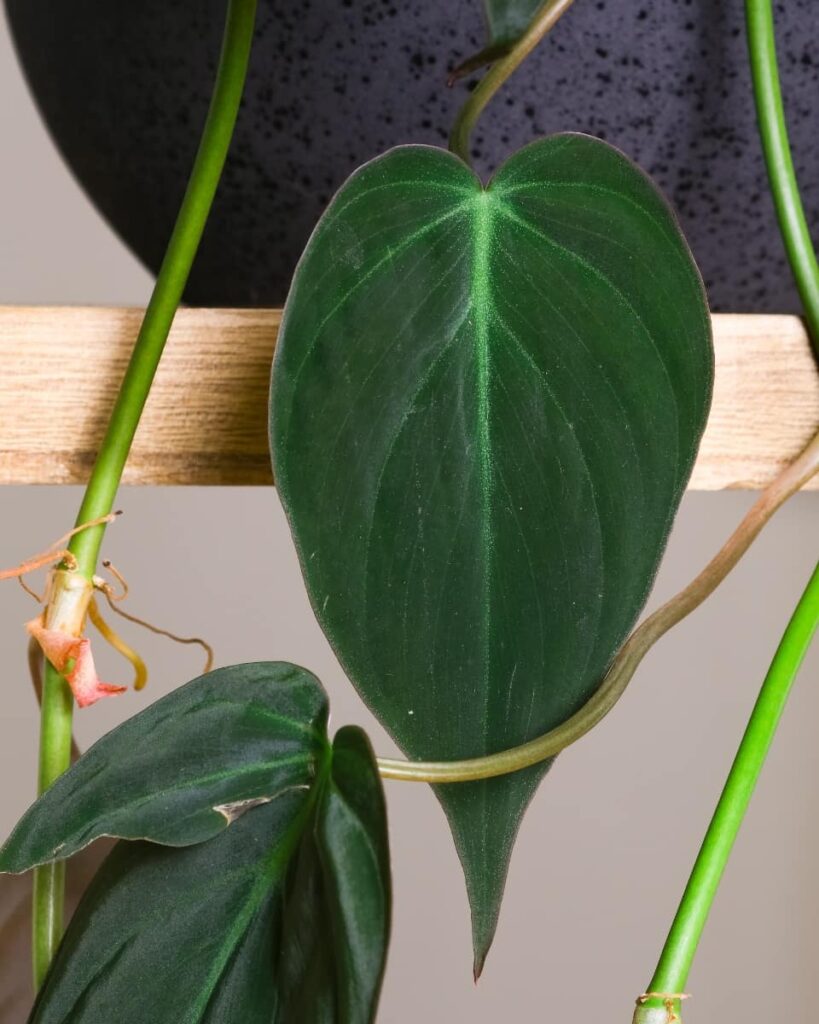
Next up is the Philodendron Micans, a favorite among plant enthusiasts. Its velvety, heart-shaped leaves showcase a deep green color with bronze undertones, giving it a unique and luxurious appearance. This variety is relatively easy to care for and thrives in moderate to bright indirect light. Additionally, the Philodendron Micans is known for its trailing growth habit, making it an excellent choice for hanging baskets or trailing down shelves.
To keep your Philodendron Micans healthy and thriving, there are some fundamental care guidelines to follow. First, make sure it gets plenty of bright, indirect light. Avoid exposing it to direct sunlight, as this can lead to leaf burns. A spot near a north-facing window or filtered sunlight from an east or west-facing window is ideal. If the light is too low, the plant may become leggy, so ensure it receives enough illumination.
Like most Philodendrons featured here, the Philodendron Micans enjoys a consistently moist but well-draining soil. Water the plant when the top inch of the soil feels dry to the touch, and be cautious not to overwater as it can lead to root rot. During the winter months or when the plant’s growth slows down, reduce watering frequency accordingly. Additionally, this plant appreciates a humid environment, especially in dry indoor conditions. You can increase humidity by misting the leaves regularly or placing the plant on a pebble tray filled with water.
As a vining plant, the Philodendron Micans benefits from occasional pruning to maintain its shape and encourage bushier growth. You can trim back long, leggy stems to promote branching. Propagation is also relatively simple with this plant, as you can root stem cuttings in water or directly in moist soil. Fertilize the Philodendron Micans once a month during the growing season (spring and summer) using a balanced liquid fertilizer. By providing the right lighting, watering, and humidity levels, you’ll have a flourishing and delightful Philodendron Micans adding elegance to your living space.
Swiss Cheese Plant
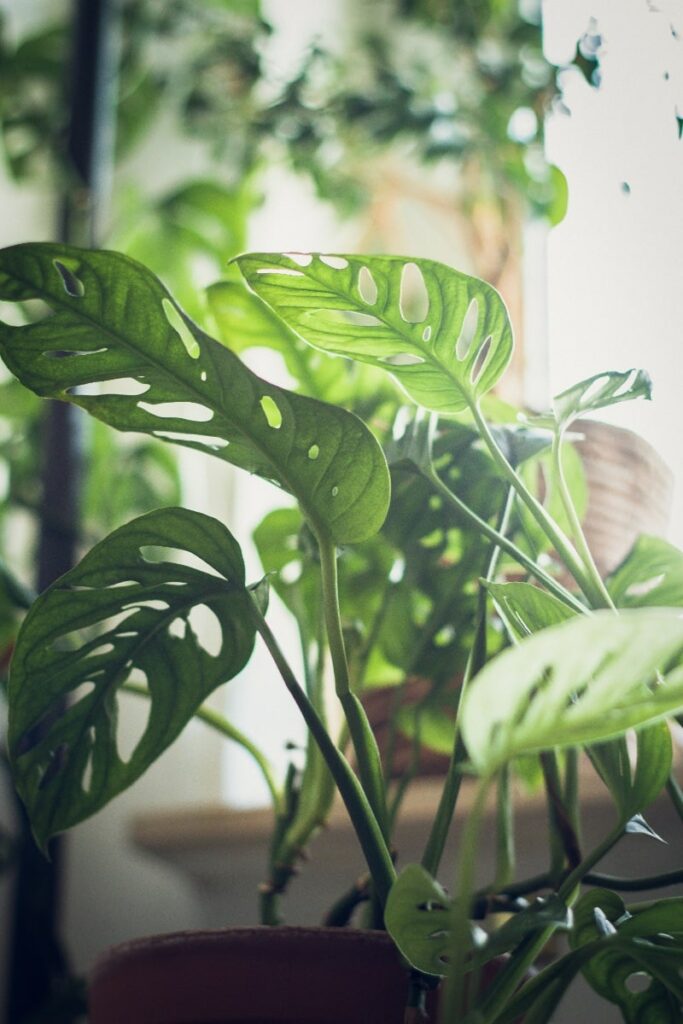
While it’s a favorite plant of ours, the Swiss Cheese Plant, or Split Leaf Philodendron is actually not a Philodendron at all, but many people make this mistake! While Monsteras and Philodendrons are two completely different plant species, they both belong to the same family, Araceae. This is why they share many similarities, like developing strong, waxy leaves from a centralized stem that has aerial roots and node segments.
Sometimes mistakenly labeled as a Philodendron Monstera, the Swiss Cheese Plant or Windowleaf Plant is incredibly popular in most nurseries. This classic and widely recognized variety is famous for its large, fenestrated leaves that have become iconic in interior design. Adding a tropical touch to any space, the Philodendron Monstera requires bright indirect light and regular watering to thrive. What sets this plant apart is its ability to grow rapidly, making it a popular choice for those looking to create a lush and jungle-like atmosphere in their homes.
Providing the right care is essential to keep the Swiss Cheese Plant plant healthy and thriving. This plant loves bright, indirect light. While it can tolerate lower light conditions, its leaves may not develop as many fenestrations or holes. Avoid exposing it to direct sunlight for prolonged periods, as it can scorch the leaves. Placing it near a north-facing window or providing filtered light from an east or west-facing window is usually ideal.
For watering, the Swiss Cheese Plant prefers a well-draining soil mix. Allow the top 1-2 inches of the soil to dry out before watering, and then water thoroughly until water drains from the bottom of the pot. It’s important not to overwater the plant, as it is susceptible to root rot. During the growing season (spring and summer), the plant may need more frequent watering, but reduce the frequency during the winter months when its growth slows down.
As the Swiss Cheese Plant is native to tropical regions, it appreciates a humid environment. You can increase humidity by misting the leaves regularly, using a humidifier, or placing the plant on a pebble tray filled with water. This will help prevent the edges of the leaves from turning brown. Fertilize the plant every 2-4 weeks during the growing season using a balanced liquid fertilizer to provide it with essential nutrients. Pruning is also beneficial for shaping the plant and removing any damaged or yellowing leaves. With proper care and attention, your Swiss Cheese Plant will flourish and become a captivating focal point in your indoor space.
These top 5 popular Philodendron plant varieties offer a range of unique features, from stunning variegation to iconic foliage. Whether you’re a seasoned plant enthusiast or just starting your plant collection, these varieties are sure to add beauty and interest to your indoor space.
4 Great Starter Philodendron Plants
Heartleaf Philodendron (Philodendron hederaceum)
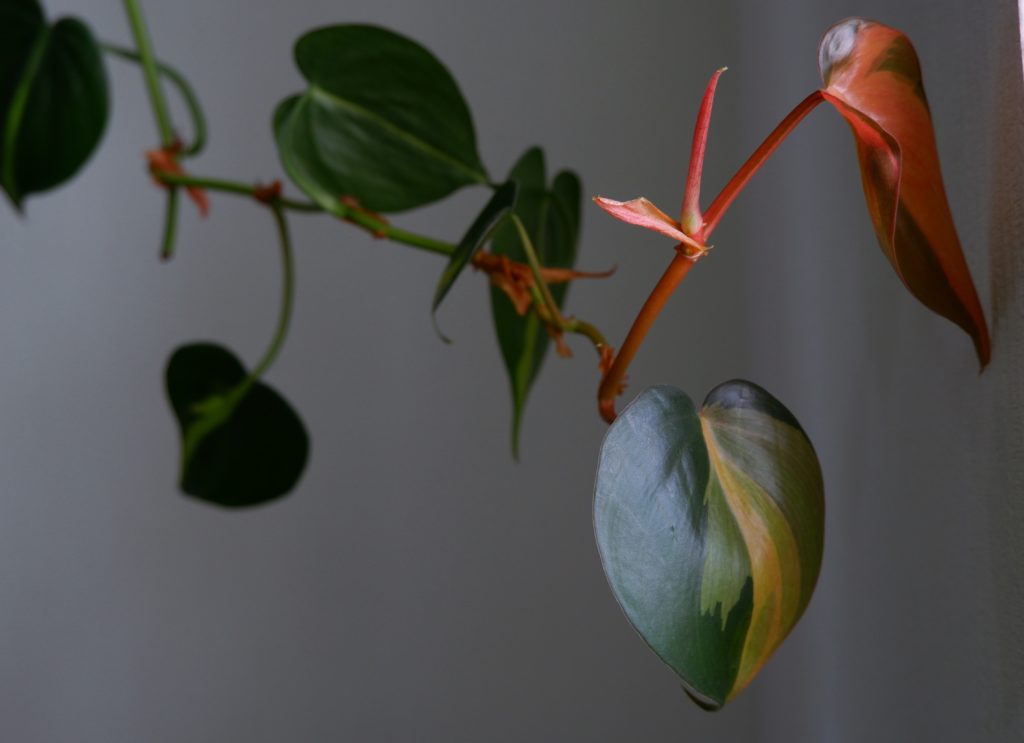
The Heartleaf Philodendron, scientifically known as Philodendron hederaceum, is undeniably one of the the most sought after and popular Philodendron plants out there. This evergreen vine, originating from the tropical regions of Central and South America, has managed to capture the hearts of plant enthusiasts worldwide, thanks to its captivating foliage and effortless care routine.
What sets the Heartleaf Philodendron apart is its distinctive heart-shaped leaves, which boast a glossy green hue and elegantly cascade down from the stems, creating a mesmerizing trailing effect. These leaves can reach an impressive length of up to 6 inches and possess a slightly undulating texture, adding an extra layer of visual allure. As for the plant’s stems, they are slender and can grow to several feet in length, making it an ideal candidate for hanging baskets or as a climbing plant with the support of a trellis or moss pole.
One of the key factors contributing to the Heartleaf Philodendron’s popularity is its remarkable adaptability to various indoor conditions. It can thrive in low light environments, making it an excellent choice for areas with limited access to natural sunlight. However, it also flourishes in bright, indirect light, which not only stimulates more robust growth but also enhances the vibrancy of its foliage. This adaptability makes it a perfect match for both seasoned plant enthusiasts and those just starting their green journey.
Another aspect that makes the Heartleaf Philodendron a crowd favorite is its low maintenance requirements. This forgiving plant can withstand occasional neglect, making it an ideal choice for busy individuals or those who may not have the greenest of thumbs. It prefers well-draining soil and should be watered when the top inch of soil feels dry. However, caution must be exercised to avoid overwatering, as it can lead to dreaded root rot. To further promote its well-being, regular misting is recommended to increase humidity levels, particularly in drier indoor environments.
Beyond its aesthetic appeal, the Heartleaf Philodendron also boasts several health benefits. Like many other houseplants, it acts as a natural air purifier, diligently eliminating toxins and releasing oxygen into its surroundings. This makes it an invaluable asset for improving indoor air quality, especially in poorly ventilated areas.
For plant enthusiasts looking to expand their collection or share the joy of Heartleaf Philodendron ownership with friends, propagation is a breeze. Stem cuttings can be easily rooted in water or directly in soil, making it a popular choice for those eager to propagate and multiply their plant family.
The Heartleaf Philodendron (Philodendron hederaceum) stands tall as a highly sought-after philodendron plant, thanks to its captivating heart-shaped leaves, adaptability to various light conditions, low maintenance requirements, and air-purifying prowess. Whether you’re a seasoned plant lover or a beginner just dipping your toes into the world of indoor greenery, this versatile and visually stunning plant is guaranteed to infuse any space with beauty and vitality.
Split-Leaf Philodendron (Philodendron bipinnatifidum)
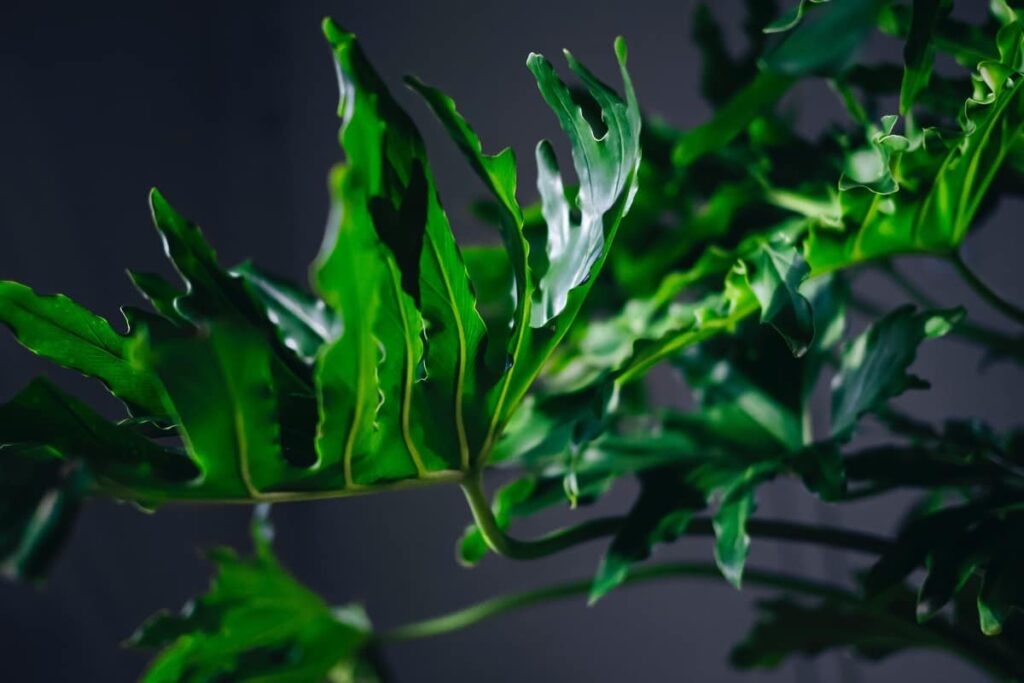
The Split-Leaf Philodendron, scientifically known as Philodendron bipinnatifidum, is undeniably one of the most sought-after and easily recognizable philodendron plants out there. Its leaves, which are large and deeply lobed, bear a striking resemblance to the shape of a split leaf, adding a touch of tropical elegance to any indoor or outdoor space you can think of.
Originating from the lush rainforests of Brazil, the Split-Leaf Philodendron has garnered immense popularity as a houseplant due to its breathtaking foliage and relatively low-maintenance requirements. These leaves can grow up to an astonishing three feet in length and are deeply incised, giving them a truly unique and eye-catching appearance. And let’s not forget about the glossy, dark green color that further enhances its already mesmerizing aesthetic appeal.
One of the many reasons why the Split-Leaf Philodendron has captured the hearts of plant enthusiasts worldwide is its remarkable ability to adapt to a wide range of lighting conditions. While it thrives in bright, indirect light, it can also tolerate lower light levels, making it an ideal choice for various indoor environments. However, it’s crucial to bear in mind that subjecting it to excessive direct sunlight can result in scorched leaves, so it’s best to provide it with filtered or diffused light.
When it comes to caring for this magnificent philodendron, it prefers a well-draining potting mix that retains some moisture without becoming waterlogged. It’s absolutely essential to allow the top inch of soil to dry out between waterings to prevent the dreaded overwatering, which can ultimately lead to root rot. If you’re looking to mimic its natural rainforest habitat, regular misting or placing the plant on a pebble tray filled with water can help increase humidity levels and keep it happy and healthy.
Now, let’s talk about its growth. The Split-Leaf Philodendron is notorious for its vigorous growth, which means it may require occasional pruning to maintain its desired shape and size. Pruning not only helps promote bushier growth but also prevents the plant from becoming leggy. And if you really want to showcase its impressive foliage, providing a sturdy support system, such as a moss pole or trellis, will allow it to climb and truly steal the show. It absolutely thrives in warm, humid environments and can be planted in shaded areas or under the protective canopy of larger trees. However, it’s crucial to shield it from frost and extreme cold temperatures, as it’s not exactly frost-tolerant.
All in all, the Split-Leaf Philodendron is an absolute favorite among plant enthusiasts and interior decorators alike. Its jaw-dropping foliage, adaptability to different lighting conditions, and relatively easy care requirements make it one of the most popular Philodendron plants for both beginners and experienced plant lovers. Whether you decide to place it in your living room, office, or garden, this philodendron plant is guaranteed to make a bold and captivating statement that will leave everyone in awe.
Velvet-Leaf Philodendron (Philodendron micans)
The Velvet-Leaf Philodendron, scientifically known as Philodendron micans, is an absolutely mesmerizing plant that has garnered an immense following among plant enthusiasts. Its foliage, oh so unique and captivating, coupled with its easy-care nature, has made it a top choice for both novices and seasoned plant lovers alike.
Prepare to be awestruck by the most remarkable feature of the Velvet-Leaf Philodendron – its velvety, heart-shaped leaves. These leaves boast a deep, luscious green hue and possess a texture so velvety, it’s as if they were plucked straight out of a fairy tale. It is this velvety appearance that has bestowed upon the plant its enchanting common name. The sheer elegance and sophistication exuded by this plant make it an absolute showstopper when it comes to sprucing up any indoor space, be it your cozy abode or your bustling office.
Behold, for this philodendron is a trailing vine, gracefully cascading down from hanging baskets or elegantly climbing up moss poles or trellises. Its trailing nature makes it the perfect choice for adding a touch of verdant beauty to your shelves, bookcases, or any elevated surface that yearns for a dash of greenery.
Now, let us delve into the reasons why the Velvet-Leaf Philodendron has become such a sensation. Its adaptability to various light conditions is nothing short of extraordinary. While it thrives in the warm embrace of bright, indirect light, it also possesses the remarkable ability to tolerate lower light levels, making it an ideal companion for areas that are deprived of abundant natural light. However, do exercise caution, dear plant enthusiasts, for exposing this delicate beauty to excessive direct sunlight may result in the scorching of its precious leaves. To ensure its well-being, it is best to provide it with filtered or diffused light, allowing it to bask in the perfect balance of illumination. It prefers soil that drains with ease, and you must water it only when the top inch of soil feels as dry as the desert sands. Overwatering, dear friends, can spell doom for this exquisite plant, as it may lead to the dreaded root rot. Therefore, it is of utmost importance to exercise patience and allow the soil to dry out between waterings. Additionally, this philodendron has a penchant for higher humidity levels, so do consider misting its leaves or placing a trusty humidifier nearby to ensure its overall health and growth.
Now, let us embark on the journey of propagation, a delightful endeavor that brings joy to the hearts of plant enthusiasts. Fear not, for propagating the Velvet-Leaf Philodendron is a relatively simple task, making it a favored choice for those who revel in expanding their plant collection. You may propagate this beauty through stem cuttings, which can be rooted either in water or directly in soil. With tender care and unwavering attention, these cuttings will flourish into new plants, allowing you to share the breathtaking beauty of this philodendron with your nearest and dearest.
The Velvet-Leaf Philodendron (Philodendron micans) is one of the most popular Philodendron plants, sought after by many due to its awe-inspiring velvety foliage, its ability to adapt to various light conditions, and its relatively undemanding nature when it comes to maintenance. Whether you choose to let it gracefully trail down from a hanging basket or train it to ascend a sturdy support, this philodendron is guaranteed to infuse any indoor space with an air of elegance and unparalleled beauty. Prepare to be captivated by its sheer magnificence!
Xanadu Philodendron (Philodendron xanadu)
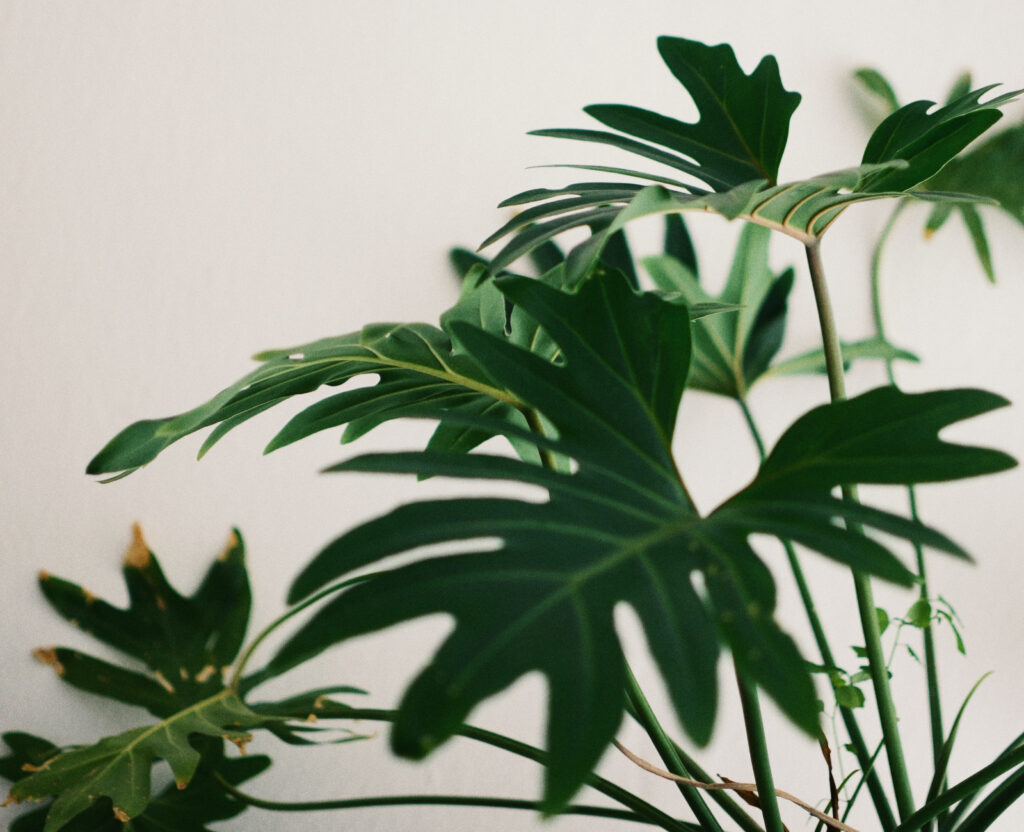
The Xanadu Philodendron, scientifically known as Philodendron xanadu, is an absolutely fascinating and captivating choice among plant enthusiasts. Its foliage is truly one-of-a-kind, with a complexity that is simply mesmerizing. Native to the vibrant lands of Brazil, this tropical plant belongs to the illustrious Araceae family and has become widely cultivated as an indoor ornamental plant.
Prepare to be astounded by the Xanadu Philodendron’s remarkable and deeply lobed leaves. These leaves possess a glossy texture and boast a distinct dark green color that exudes an air of elegance. Their deeply divided nature gives them a feathery appearance, and they grow in such a dense and compact manner that the plant becomes a veritable bushy wonder.
What makes the Xanadu Philodendron truly remarkable is its ability to thrive with minimal effort. This plant is a dream come true for both seasoned plant owners and novices alike. It flourishes in bright, indirect light, but it can also tolerate lower light conditions, making it a versatile choice for a variety of indoor environments. However, it is crucial to shield it from direct sunlight, as the intensity can scorch those beautiful leaves.
When it comes to caring for the Xanadu Philodendron, it prefers soil that drains well while retaining some moisture. Watering the plant thoroughly and allowing the top inch of soil to dry out before watering again is essential. Striking the perfect balance is key, as overwatering can lead to root rot, a situation we definitely want to avoid.
This particular philodendron variety is renowned for its adaptability to different humidity levels, although it generally prefers higher humidity. To create a more humid environment, especially in drier climates or during the winter months when indoor heating can cause dry air, regular misting or placing the plant on a pebble tray filled with water can work wonders.
While the Xanadu Philodendron may be a slow grower, it has the potential to reach impressive heights and widths over time. With an average growth of 2-4 feet, it is the perfect choice for medium-sized indoor spaces. To maintain its compact shape and prevent it from becoming too leggy, regular pruning is highly recommended.
If you’re interested in propagating the Xanadu Philodendron, fear not, for it is a relatively straightforward process. Stem cuttings are the way to go. Simply take a healthy stem cutting with a few leaves attached and place it in a well-draining potting mix. Keep the soil moist, provide indirect light, and within a few weeks, roots should start to develop.
The Xanadu Philodendron is an absolute gem that captivates with its unique foliage, adaptability, and relatively easy care requirements. Whether you choose to showcase it as a standalone statement plant or incorporate it into a lush indoor jungle, this philodendron variety will undoubtedly infuse any space with a touch of tropical beauty. Prepare to be enchanted!
Characteristics and Care Tips for Each Philodendron Variety
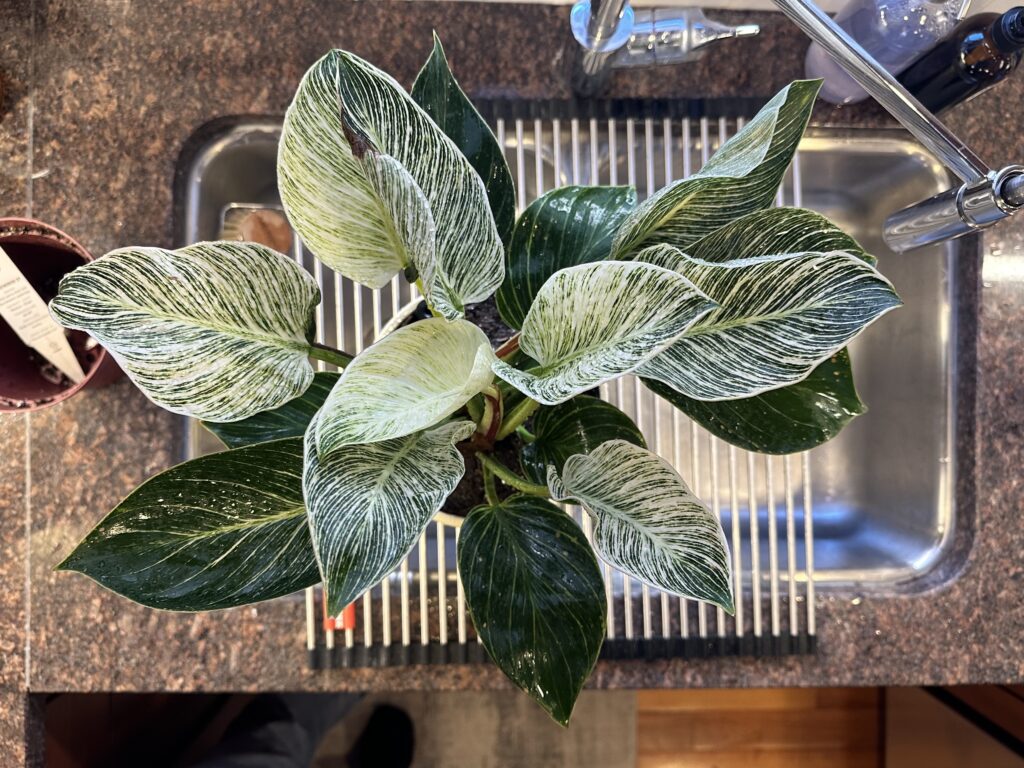
1. Behold the Philodendron Birkin, a mesmerizing plant with leaves that boast a dark green hue adorned with creamy-white pinstripes. Its appearance is truly one-of-a-kind, capturing attention effortlessly. This petite plant grows at a leisurely pace, making it an ideal choice for adorning tabletops or shelves.
When it comes to caring for the Philodendron Birkin, it craves bright, indirect light, although it can tolerate lower light conditions. Ensuring well-draining soil is crucial, and watering should only be done when the top inch of soil feels dry. Overwatering is a big no-no, as it can lead to the dreaded root rot. Moderate humidity levels are preferred, and don’t forget to give those leaves a refreshing mist every now and then to keep them pristine and free from dust.
2. Prepare to be captivated by the Philodendron Brasil, a beloved variety that showcases heart-shaped leaves adorned with vibrant green and yellow variegation. This trailing plant can be showcased in hanging baskets or allowed to climb with the assistance of a sturdy support structure. With its rapid growth, it effortlessly fills empty spaces with its lush foliage.
To keep the Philodendron Brasil thriving, it yearns for bright, indirect light, although it can tolerate lower light conditions. Opt for well-draining soil and water when the top inch of soil feels parched. This particular variety appreciates higher humidity levels, so don’t hesitate to give those leaves a delightful misting or place a trusty humidifier nearby. Regular pruning of the trailing vines ensures a compact and bushy appearance that will leave you in awe.
3. Brace yourself for the awe-inspiring Philodendron Pink Princess, a highly coveted variety that boasts foliage that is nothing short of breathtaking. Its heart-shaped leaves are predominantly dark green, but they are adorned with splashes of pink, creating a dramatic and unique visual spectacle. As a climber, this plant can reach impressive heights when provided with a sturdy support structure.
When it comes to caring for the Philodendron Pink Princess, it craves bright, indirect light, although it can tolerate lower light conditions. Well-draining soil is a must, and watering should be done when the top inch of soil feels dry. This variety thrives in higher humidity levels, so don’t forget to give those leaves a refreshing mist or place a trusty humidifier nearby. Regular pruning is essential to encourage bushier growth and maintain the vibrancy of its foliage.
4. Prepare to be enchanted by the Philodendron Micans, also known as the Velvet Leaf Philodendron, which boasts velvety, heart-shaped leaves that are simply irresistible. These leaves exhibit a rich green color with a hint of bronze, creating a texture and appearance that is truly unparalleled. Whether showcased in hanging baskets or allowed to climb with the help of a support structure, this trailing plant is a sight to behold.
To ensure the Philodendron Micans thrives, it craves bright, indirect light, although it can tolerate lower light conditions. Opt for well-draining soil and water when the top inch of soil feels dry. This variety appreciates higher humidity levels, so don’t hesitate to give those leaves a delightful misting or place a trusty humidifier nearby. Regular pruning of the trailing vines ensures a compact and bushy appearance that will leave you in awe.
Remember, while these care tips provide general guidelines, it’s crucial to observe the specific needs of your beloved plants and make adjustments accordingly. With proper care, these popular philodendron varieties will flourish and bring unparalleled beauty to any indoor space.
Frequently Asked Questions
Are philodendron plants easy to care for?
Yes, philodendron plants are generally easy to care for. They are known for their resilience and ability to thrive in various conditions. They require moderate watering, indirect sunlight, and well-draining soil. Philodendrons are great for beginners and busy individuals who may not have a lot of time to dedicate to plant care.
Do philodendron plants require a lot of sunlight?
No, philodendron plants do not require direct sunlight. In fact, they prefer bright, indirect light. Placing them near a window with filtered light or in a well-lit room is usually sufficient. Direct sunlight can scorch their leaves, so it’s best to avoid exposing them to intense rays.
How often should I water my philodendron plant?
The frequency of watering depends on various factors such as the size of the plant, the type of pot it’s in, and the environmental conditions. As a general rule, it’s best to allow the top inch of soil to dry out before watering again. Overwatering can lead to root rot, so it’s important to ensure the soil has proper drainage.
Can philodendron plants be grown in water?
Yes, philodendron plants can be grown in water. They are known to be excellent candidates for water propagation. Simply place a cutting with a few nodes in a container of water, ensuring that the nodes are submerged. Change the water regularly and wait for roots to develop before transferring the cutting to soil.
Are philodendron plants toxic to pets?
Yes, philodendron plants are toxic to pets. They contain calcium oxalate crystals, which can cause irritation and swelling if ingested. It’s important to keep philodendrons out of reach of curious pets and to seek veterinary attention if any signs of ingestion occur.
